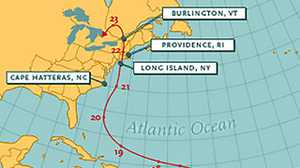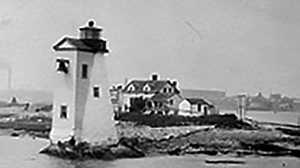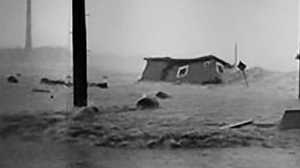The Hurricane's Aftermath

In the aftermath of the Hurricane of 1938, more aspects of the disaster became clear. Drinking water was potentially contaminated. Twenty thousand miles of electric and telephone lines had been knocked down, cutting off entire communities from the outside world. Police, firemen and other service crews were working constantly, often improvising at tasks they were not trained for.
The Fall River, Massachusetts city water storage tank was crushed and had to be replaced. Even as the stored water was lost, the flood of seawater raised concerns about the purity of the water table. One local board of health put up notices advising against drinking well water: "NOTICE DO NOT USE ANY WATER FOR DRINKING OR COOKING IN FLOODED AREA UNTIL FURTHER NOTICE PER ORDER BOARD OF HEALTH." In another community, police rationed out drinking water to residents by the pail-full.

The collapse of the telephone poles and the flooding of exchange buildings cut off more than half a million telephones. Three hundred and one thousand phones of the New England Telephone & Telegraph Company, servicing Massachusetts, Rhode Island, New Hampshire, Vermont and Maine were out, accounting for about a quarter of the total. The Southern New England Telephone Company in the state of Connecticut lost 75,000 phones, and about 25% of total service.
More specific areas had higher percentages of damage. From Fall River to Falmouth, 13,000 out of 40,000 phones were out. In Rhode Island, particularly the city of Providence, close to 50% of the telephones were not working. All the lines to Cape Cod were downed when a bridge was swept away. Ham radio enthusiasts, like W. Everett Briggs of Brockton, Massachusetts, used their equipment to aid state police in coordinating efforts.
Local telephone repair crews were assisted by telephone company crews from as far away as Illinois, Indiana, Ohio, Michigan, Virginia, Arkansas and Nevada. Twenty-three hundred men from those crews worked through the night in New England to try to reconnect the 240 or so communities that were completely isolated. The Bell System estimated that the repairs required 400 miles of cable, 31,000 poles, 72 million feet of wire and 50 carloads of telephone hardware.
Electrical lines were also downed, and in areas where they were still carrying current, residents had to step carefully around them. The first problem with electric service on Cape Cod was an accumulation of salt spray on the insulators of the electrical towers. The New Bedford Gas and Edison Light Company stations were flooded, as were many other electrical plants.
The spread of typhoid was feared. The Hartford Courant reported: "The Boards of Health of every large city provide serum for all those who lived or worked in the flooded areas."
Fire departments that had to contend with electrical fires immediately after the storm were busy night and day pumping water out of commercial and residential cellars.
The floods stranded the citizens of Ware, Massachusetts, for days; planes dropped food, vaccines and medicines to residents. The water scoured the city so brutally that Main Street was left a chasm in which sewer pipes could be seen. In a town of less than 8,000 people, damage was estimated at $916,000.
Major cash crops were damaged, as well. Apple orchards and sugar maple farms as far north as Maine took years to recover from the wind damage.
A total of 19,608 families applied for assistance at the Red Cross after the hurricane and floods. By October 20, in the midst of an economic depression, $22,000 was collected by that agency for the victims.
In the wake of the Hurricane of 1938, entire shorelines had been altered. Perceptions and priorities had also changed. On the eve of war in Europe, the U.S. War Department advocated building sea walls and allocated $4.75 million for flood control work in New England.
The material damage of the storm has been calculated to be $4.7 billion in 2001 dollars. Six hundred and eighty lives were lost in the destruction and rising waters. No hurricane since then has claimed the lives of so many Americans.







